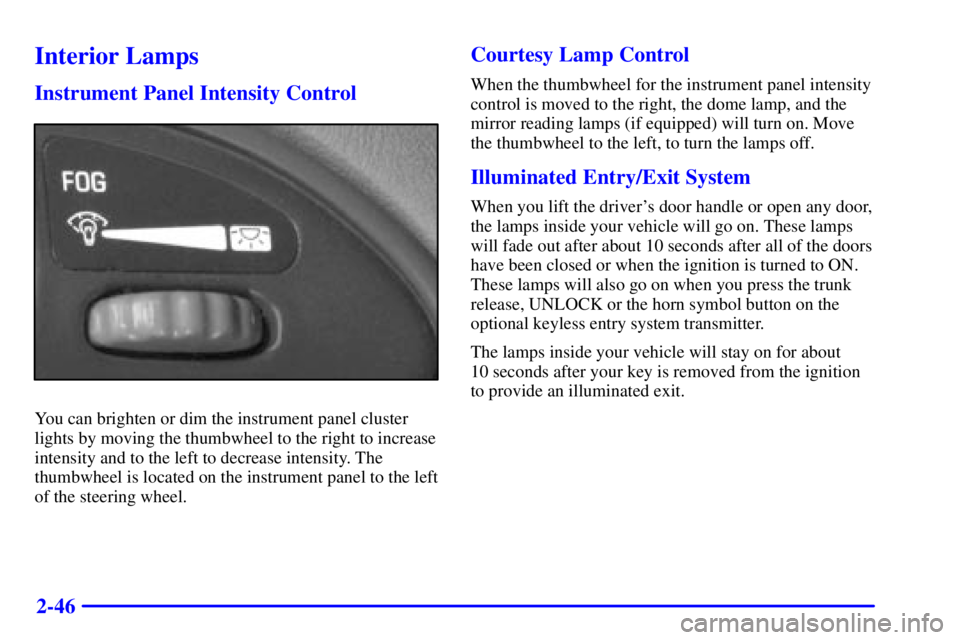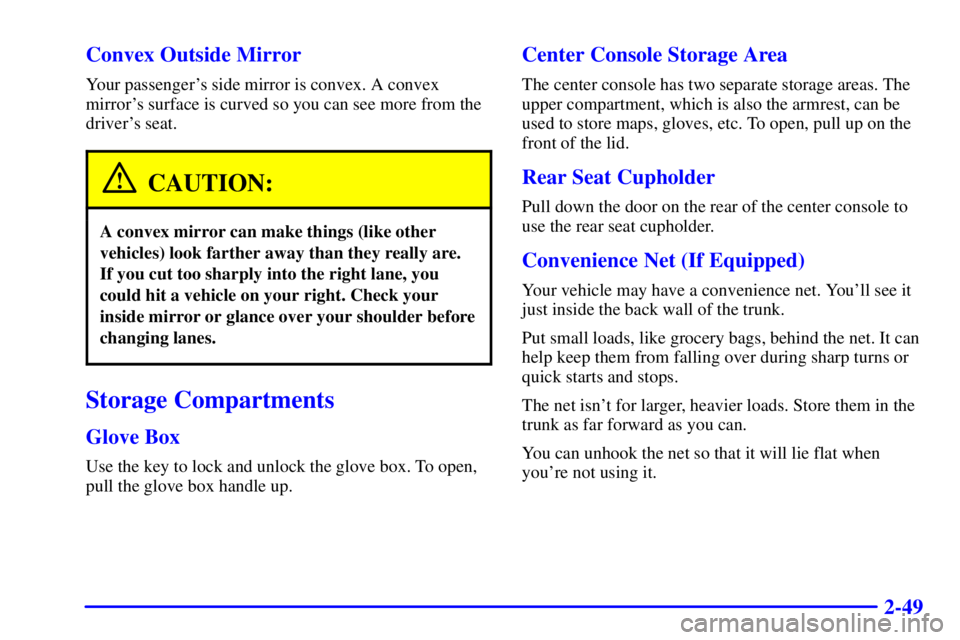Page 4 of 341
Table of Contents
Windows
Keys and Door Locks
Remote Keyless Entry System (If Equipped)
Remote Trunk Release
Automatic Transaxle (If Equipped)
Manual Transaxle (If Equipped)
Parking Brake
Tilt Wheel
Turn Signal/Multifunction LeverWindshield Wipers
Cruise Control (If Equipped)
Exterior and Interior Lamps
Mirrors
Storage Compartments
Convenience Net (If Equipped)
Sunroof (Option)
Instrument Panel, Warning Lights and Gages Seats and Seat Controls
Safety BeltsSupplemental Restraint System (SRS)
Restraint Systems for Children
Section
1
Section
2
Seats and Restraint Systems
Features and Controls
ii
Page 71 of 341

2-
2-1
Section 2 Features and Controls
Here you can learn about the many standard and optional features on your vehicle, and information on starting,
shifting and braking. Also explained are the instrument panel and the warning systems that tell you if everything is
working properly
-- and what to do if you have a problem.
2
-2 Windows
2
-4 Keys
2
-6 Door Locks
2
-11 Remote Keyless Entry System (If Equipped)
2
-14 Trunk
2
-17 Theft
2
-18 Passlock�
2-19 New Vehicle ªBreak-Inº
2
-19 Ignition Positions
2
-20 Starting Your Engine
2
-22 Engine Coolant Heater (Option)
2
-23 Automatic Transaxle Operation
2
-27 Manual Transaxle Operation
2
-29 Parking Brake
2
-30 Shifting Into PARK (P)
(Automatic Transaxle Only)
2
-32 Shifting Out of PARK (P)
(Automatic Transaxle Only)2
-33 Parking Your Vehicle/Key Removal
(Manual Transaxle Models Only)
2
-33 Parking Over Things That Burn
2
-34 Engine Exhaust
2
-34 Running Your Engine While You're Parked
(Automatic Transaxle)
2
-35 Tilt Wheel
2
-36 Turn Signal/Multifunction Lever
2
-43 Exterior Lamps
2
-46 Interior Lamps
2
-48 Mirrors
2
-49 Storage Compartments
2
-50 Ashtray and Cigarette Lighter (If Equipped)
2
-50 Sun Visors
2
-51 Sunroof (Option)
2
-52 The Instrument Panel -- Your
Information System
2
-56 Warning Lights, Gages and Indicators
Page 116 of 341

2-46
Interior Lamps
Instrument Panel Intensity Control
You can brighten or dim the instrument panel cluster
lights by moving the thumbwheel to the right to increase
intensity and to the left to decrease intensity. The
thumbwheel is located on the instrument panel to the left
of the steering wheel.
Courtesy Lamp Control
When the thumbwheel for the instrument panel intensity
control is moved to the right, the dome lamp, and the
mirror reading lamps (if equipped) will turn on. Move
the thumbwheel to the left, to turn the lamps off.
Illuminated Entry/Exit System
When you lift the driver's door handle or open any door,
the lamps inside your vehicle will go on. These lamps
will fade out after about 10 seconds after all of the doors
have been closed or when the ignition is turned to ON.
These lamps will also go on when you press the trunk
release, UNLOCK or the horn symbol button on the
optional keyless entry system transmitter.
The lamps inside your vehicle will stay on for about
10 seconds after your key is removed from the ignition
to provide an illuminated exit.
Page 117 of 341

2-47 Mirror Reading Lamps
Press the switch next to each lamp to turn them on
and off.
Three-Position Dome Lamp (If Equipped)
The switch on this lamp has three positions. The ON
position will turn on the light. The DOOR position will
turn on the light whenever a door is opened or when the
instrument panel intensity control thumbwheel is moved
to the right. The OFF position will shut off the lamp
completely, even when a door is opened.
Your vehicle may also have two reading lamps as part of
the dome lamp. Push the lens of either lamp to turn them
on and off.
Trunk Lamp
The trunk lamp comes on when you open your trunk.
Battery Saver
Your vehicle is equipped with a battery saver feature
designed to protect your vehicle's battery.
When any interior lamp (trunk, mirror reading lamps,
dome lamp or glove box) is left on when the ignition is
turned off, the battery saver system will automatically
shut the lamp off after 20 minutes. This will avoid
draining the battery.
To reactivate the interior lamps, do one of the following:
�Lift the driver's door handle,
�open any door,
�press any remote keyless entry transmitter button
(if equipped),
�press the power door lock switch,
�press the remote trunk release, or
�turn the lamp that was left on to off then to on again.
Page 118 of 341

2-48
Mirrors
Inside Day/Night Rearview Mirror
This mirror can be adjusted two ways. First, to adjust
the height of the mirror, adjust the arm that connects the
mirror to the windshield. Then adjust the angle of the
mirror, by moving the mirror to a position that allows
you to see out of the back window.
To reduce glare from any headlamps behind you, move
the lever toward you to the night position. To return the
mirror to the daytime position, move the lever away
from you.
Manual Remote Control Mirror
The outside rearview mirror should be adjusted so you
can see a little of the side of your vehicle when you are
sitting in a comfortable driving position.
Adjust the driver's side outside mirror with the control
lever on the driver's door.
To adjust your passenger's outside mirror, sit in the
driver's seat and have a passenger adjust the mirror
for you.
Power Remote Control Mirror
(If Equipped)
This selector knob
controls both outside
rearview mirrors.
Select the mirror you want to adjust by turning the knob
to the left or right. Adjust each mirror so that you can
see the side of your vehicle when you are sitting in a
comfortable driving position.
Turn the knob to the center to turn the remote control
mirror off.
Page 119 of 341

2-49 Convex Outside Mirror
Your passenger's side mirror is convex. A convex
mirror's surface is curved so you can see more from the
driver's seat.
CAUTION:
A convex mirror can make things (like other
vehicles) look farther away than they really are.
If you cut too sharply into the right lane, you
could hit a vehicle on your right. Check your
inside mirror or glance over your shoulder before
changing lanes.
Storage Compartments
Glove Box
Use the key to lock and unlock the glove box. To open,
pull the glove box handle up.
Center Console Storage Area
The center console has two separate storage areas. The
upper compartment, which is also the armrest, can be
used to store maps, gloves, etc. To open, pull up on the
front of the lid.
Rear Seat Cupholder
Pull down the door on the rear of the center console to
use the rear seat cupholder.
Convenience Net (If Equipped)
Your vehicle may have a convenience net. You'll see it
just inside the back wall of the trunk.
Put small loads, like grocery bags, behind the net. It can
help keep them from falling over during sharp turns or
quick starts and stops.
The net isn't for larger, heavier loads. Store them in the
trunk as far forward as you can.
You can unhook the net so that it will lie flat when
you're not using it.
Page 120 of 341
2-50
Ashtray and Cigarette Lighter
(If Equipped)
To use the lighter, just push it in all the way and let go.
NOTICE:
Don't put papers and other things that burn into
your ashtrays. If you do, cigarettes or other
smoking materials could set them on fire,
causing damage.
NOTICE:
Don't hold a cigarette lighter in with your hand
while it is heating. If you do, it won't be able to
back away from the heating element when it's
ready. That can make it overheat, damaging the
lighter and the heating element.
You can also remove the cigarette lighter to plug in
additional accessories. Be sure to follow the proper
installation instructions that are included with any
electrical accessory you install.
Sun Visors
To block out glare, you can swing down the visors.
You can also swing them to the side. The visors also
have extenders that you can pull out for added coverage.
Visor Vanity Mirror
Swing down the sun visor and lift the cover to expose
the vanity mirror.
Page 187 of 341

4-14
�Do not get too close to the vehicle you want to
pass while you're awaiting an opportunity. For one
thing, following too closely reduces your area of
vision, especially if you're following a larger
vehicle. Also, you won't have adequate space if the
vehicle ahead suddenly slows or stops. Keep back a
reasonable distance.
�When it looks like a chance to pass is coming up,
start to accelerate but stay in the right lane and don't
get too close. Time your move so you will be
increasing speed as the time comes to move into the
other lane. If the way is clear to pass, you will have a
ªrunning startº that more than makes up for the
distance you would lose by dropping back. And if
something happens to cause you to cancel your pass,
you need only slow down and drop back again and
wait for another opportunity.
�If other cars are lined up to pass a slow vehicle, wait
your turn. But take care that someone isn't trying to
pass you as you pull out to pass the slow vehicle.
Remember to glance over your shoulder and check
the blind spot.�Check your mirrors, glance over your shoulder, and
start your left lane change signal before moving out
of the right lane to pass. When you are far enough
ahead of the passed vehicle to see its front in your
inside mirror, activate your right lane change signal
and move back into the right lane. (Remember that
your right outside mirror is convex. The vehicle you
just passed may seem to be farther away from you
than it really is.)
�Try not to pass more than one vehicle at a time
on two
-lane roads. Reconsider before passing the
next vehicle.
�Don't overtake a slowly moving vehicle too rapidly.
Even though the brake lamps are not flashing, it may
be slowing down or starting to turn.
�If you're being passed, make it easy for the
following driver to get ahead of you. Perhaps you
can ease a little to the right.